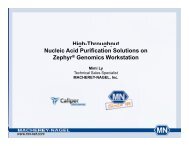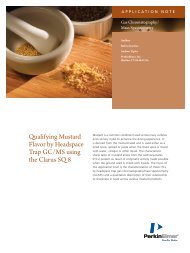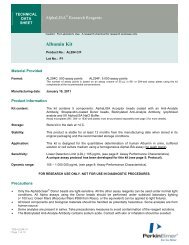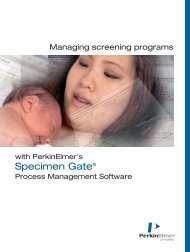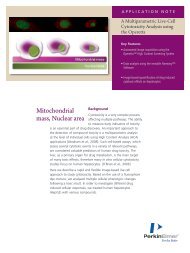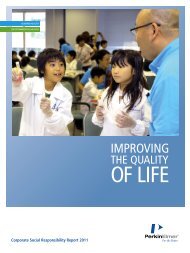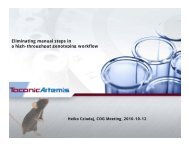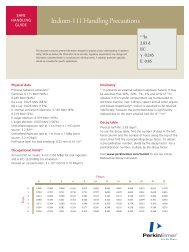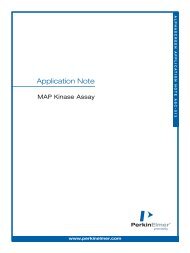Fully Automated Sample Processing and HTP ... - PerkinElmer
Fully Automated Sample Processing and HTP ... - PerkinElmer
Fully Automated Sample Processing and HTP ... - PerkinElmer
Create successful ePaper yourself
Turn your PDF publications into a flip-book with our unique Google optimized e-Paper software.
<strong>Fully</strong> <strong>Automated</strong> <strong>Sample</strong> <strong>Processing</strong> <strong>and</strong> <strong>HTP</strong> Microchip CGE<br />
Analysis for Rapid Identification of Microbial Production Strains<br />
Pfēnex Expression Technology TM<br />
Jeff Allen<br />
jallen@pfenex.com<br />
Caliper Owners Group Meeting<br />
La Jolla, CA<br />
May 20, 2010
Today’s Discussion<br />
Background of Pfēnex Expression Technology TM<br />
<strong>HTP</strong> expression analysis<br />
Automation of sample preparation<br />
Case Study<br />
Discovery ● Development ● Production<br />
2
Who we are:<br />
• Located in San Diego, California<br />
• Premier technology, facility <strong>and</strong><br />
capability in protein production <strong>and</strong><br />
strain engineering using<br />
Pseudomonas fluorescens<br />
• Current partner programs span<br />
from discovery to clinical<br />
development stages<br />
• Pfēnex innovator programs in<br />
vaccines, reagent proteins <strong>and</strong><br />
biosimilars/biobetters<br />
• ~32,000 square feet of space in<br />
Sorrento Valley housing capabilities in<br />
molecular biology, analytical<br />
biochemistry, fermentation,<br />
downstream processing <strong>and</strong> product<br />
development<br />
Discovery ● Development ● Production<br />
3
Pfēnex Expression Technology<br />
• P. fluorescens is a nonpathogenic, Gram-negative, obligate aerobic,<br />
bacterium<br />
• Genomic, “systems biology” approach to host strain construction enables<br />
rapid <strong>and</strong> reliable strain development<br />
• Combine expression plasmids for multiple expression strategies (promoter,<br />
ribosome binding site & secretion signal) with multiple host strains<br />
• Develop effective high throughput growth <strong>and</strong> assay methods<br />
• Rapid development of production strains yielding high titers of quality<br />
protein<br />
• Altered paradigm: Discard linear, iterative approach, adopt parallel, high<br />
throughput method for microbial strain development<br />
Discovery ● Development ● Production<br />
4
Pfēnex <strong>HTP</strong> Strain Development<br />
>85% Success Rate for Proteins that Previously Failed in Other System<br />
Examples of Stalled Development:<br />
Protein Type Alternative Host Pfēnex Results<br />
Fab Yeast: quality issues, low yield 10-20X yield improvement<br />
high quality at 1L scale<br />
Microbial outer membrane protein E. coli: no expression Soluble active expression g/L;<br />
1.0L scale<br />
Growth Factor<br />
Therapeutic Enzyme<br />
Human Cytokine<br />
Yeast: low yield, degradation,<br />
glycosylation<br />
E. coli: undesirable isoforms,<br />
quality issues<br />
E. coli- inclusion bodies; no<br />
soluble expression<br />
20X yield improvement at <strong>HTP</strong><br />
scale, high quality, active<br />
10X yield improvement; no<br />
isoform issues<br />
Soluble active expression;<br />
elimination of refold step<br />
Multimeric Antibody Derivative CHO- low expression(
Pfēnex Platform:<br />
The New St<strong>and</strong>ard for Production Strain Engineering <strong>and</strong> Protein Production<br />
DNA constructs<br />
UPSTREAM<br />
DOWNSTREAM MIDSTREAM<br />
strain selection<br />
fermentation<br />
primary recovery<br />
purification<br />
characterization <strong>and</strong><br />
analysis<br />
data analysis/management & bioinformatics<br />
process analytical<br />
2<br />
plasmids<br />
4+ promoters<br />
3 ribosome binding sites<br />
25 secretion leaders<br />
30 chaperone/disulfide bond<br />
isomerase overexpression plasmids<br />
100+ protease clean deletion mutants, multiple deletions<br />
Thous<strong>and</strong>s of unique combinations enable optimal strain<br />
discovery for biopharmaceutical protein production<br />
Discovery ● Development ● Production<br />
6
Periplasmic Targeting of Recombinant Proteins<br />
Outer membrane<br />
Periplasm<br />
Inner membrane<br />
DNA<br />
Promoter +1<br />
mRNA<br />
Cytoplasm<br />
Folding Modulators<br />
Disulfide Bond Formation<br />
Signal peptide<br />
Terminator<br />
Gene of Interest<br />
Shine-Dalgarno<br />
Oxido–reductases DsbA <strong>and</strong> DsbB<br />
Disulfide isomerases DsbD, DsbC, <strong>and</strong> DsbG<br />
Sec<br />
Recombinant<br />
Protein<br />
Signal peptidase<br />
Inactive<br />
Active Protein<br />
Extracellular space<br />
Simplified<br />
recovery<br />
Discovery ● Development ● Production
Value of Secretion Leader Screening<br />
96 well <strong>HTP</strong> growth; CGE analysis<br />
10 unique leaders + scFv (27kDa)<br />
Soluble<br />
Leaders,<br />
3 lanes each<br />
null A B C D Cyto E F G H I J<br />
Insoluble<br />
Varying levels of processing, solubility <strong>and</strong> target yield with different secretion leaders<br />
Discovery ● Development ● Production<br />
8
Value of Protease Deficient Hosts<br />
Problem: Yeast toolbox ineffective resulting in proteolytic degradation, very high<br />
heterogeneous glycosylation<br />
“Stacked” protease deletion strain with very high titer (>1 g/L in 96 well), superior<br />
product quality, no degradation or heterogeneity, soluble <strong>and</strong> active protein<br />
Protease Knockout<br />
Null 1 2 1+2 STD Spike<br />
0.5mg/mL<br />
Host Strain Choice Controls<br />
Expression Level <strong>and</strong> Quality<br />
Full length<br />
clipped<br />
Discovery ● Development ● Production<br />
9
<strong>HTP</strong> Growth <strong>and</strong> Expression<br />
2<br />
plasmids<br />
4+ promoters<br />
3 ribosome binding sites<br />
25 secretion leaders<br />
• High throughput parallel processing<br />
• Yield, quality <strong>and</strong> speed create significant advantages<br />
in real <strong>and</strong> opportunity costs<br />
30 chaperone/disulfide bond<br />
isomerase overexpression plasmids<br />
100+ protease clean deletion mutants, multiple deletions<br />
Strain Construction<br />
+<br />
plasmids host strains<br />
Seed<br />
electroporate <strong>and</strong> grow<br />
transformants on<br />
selective media<br />
<strong>HTP</strong> Expression<br />
Inoculate seed<br />
culture into <strong>HTP</strong><br />
medium<br />
Replicate cultures<br />
will be grown for 24<br />
h at 30 °C prior to<br />
induction<br />
Harvest<br />
<strong>and</strong><br />
Analysis<br />
Thous<strong>and</strong>s of strains evaluated in
Process analytical: 1 st <strong>and</strong> 2 nd tier screens<br />
challenge: to accurately analyze target in complex mixture of solids, protein, DNA, etc. in timely fashion<br />
Quantity addressed<br />
Quality addressed<br />
1 st tier<br />
analysis<br />
2 nd tier<br />
analysis<br />
<strong>Sample</strong>s: 1000s<br />
<strong>Sample</strong>s: 10s to 100s<br />
<strong>HTP</strong> Expression<br />
30-50 OD Achieved<br />
<strong>HTP</strong> SDS-CGE<br />
<strong>HTP</strong> BLI<br />
MS<br />
HPLC<br />
96-well format<br />
90 min per plate<br />
96-well format<br />
30 min per plate<br />
+ Western Blot <strong>and</strong> other methods<br />
measure target mass yield<br />
measure fragments, aggregates, etc.<br />
Discovery ● Development ● Production
<strong>HTP</strong> Microchip SDS-CGE<br />
Labchip ® GXII<br />
Protein chip<br />
Schematic layout of the<br />
microchannels of protein chip.<br />
The red channels are filled with<br />
sieving matrix.<br />
LC90<br />
Features of the Labchip GXII:<br />
• Capable of interfacing with plate robotics<br />
• Increased chip stability<br />
• On-line chip priming<br />
• Dry focusing<br />
• Chip RFID reader keeps user informed of onchip<br />
reagent <strong>and</strong> chip lifetime status<br />
• CFR21 Part 11 compliance<br />
• Great improvements in software<br />
Discovery ● Development ● Production<br />
12
Expression analysis: <strong>Sample</strong> Preparation Bottleneck<br />
challenge: to accurately analyze target in complex mixture of solids, protein, DNA, etc. in timely fashion<br />
samples:<br />
whole cells<br />
<strong>HTP</strong> strain selection<br />
1000s of samples<br />
Fermentation<br />
Optimization<br />
sample<br />
h<strong>and</strong>ling<br />
<strong>and</strong> cell<br />
lysis<br />
separation<br />
of soluble<br />
<strong>and</strong><br />
insoluble<br />
fractions<br />
analysis<br />
100s of samples<br />
Goal<br />
“Old” process steps<br />
semi-automated,<br />
manual labels,<br />
labor intensive<br />
centrifugation in<br />
multiple rounds;<br />
manual h<strong>and</strong>ling<br />
Improve throughput <strong>and</strong> efficiencies through automation while<br />
maintaining high-quality analytical support<br />
Discovery ● Development ● Production
<strong>Automated</strong> project launched in 2009<br />
Integration<br />
Team Systems<br />
Engineers<br />
Integration<br />
Systems<br />
Design Team<br />
Integration<br />
Team Project<br />
Managers<br />
Global<br />
Service<br />
Division<br />
Biology<br />
Application<br />
Group<br />
Caliper ACES<br />
ACES<br />
Business<br />
Management<br />
An integrated Caliper team worked with the Pfenex team to develop<br />
automation of key process steps<br />
Discovery ● Development ● Production
Robotically Enabled <strong>Sample</strong> Preparation<br />
Integrated robotic platform comprised of multiple workstations where<br />
sample plates are moved from station to station using a central robotic arm<br />
• Plates (96-well) of strains harvested <strong>and</strong> stored in a chilled hotel<br />
• Cultures are sonicated <strong>and</strong> then centrifuged to separate soluble <strong>and</strong><br />
insoluble fractions<br />
• Fractions are recovered <strong>and</strong> aliquoted using a liquid h<strong>and</strong>ling robot<br />
• <strong>Sample</strong>s prepped for <strong>HTP</strong> microchip SDS-CGE analysis<br />
• <strong>Sample</strong>s loaded to GX II units <strong>and</strong> analyzed<br />
Parallel processed, robotically enabled strain engineering technology<br />
increases throughput <strong>and</strong> speed of development<br />
Discovery ● Development ● Production
Case Study<br />
Press Release 5/17/2010<br />
Discovery ● Development ● Production<br />
16
Structure of the influenza hemagglutinin monomer<br />
Removable<br />
purification tag<br />
attached here<br />
Membrane domain<br />
removed<br />
HA monomer. Sites A-E are immunodominant epitopes (From Fields Virology, 2nd ed, Fields &<br />
Knipe, eds, Raven Press, 1990, Fig.40-4)<br />
Discovery ● Development ● Production<br />
Pfenex Confidential, Not US government
<strong>HTP</strong> Growth <strong>and</strong> Expression Analysis Workflow<br />
seed<br />
pXXX<br />
+<br />
Multiple Expression<br />
Plasmids<br />
Pfēnex<br />
Multiple Hosts,<br />
Multiple<br />
Phenotypes<br />
320 unique expression<br />
strains constructed<br />
Electroporate (96<br />
well) <strong>and</strong> grow<br />
transformants on<br />
selective medium<br />
Prepare seed<br />
plate<br />
Grow triplicates<br />
for each<br />
recombinant<br />
strain<br />
<strong>HTP</strong> Expression<br />
SDS-CGE<br />
Titer<br />
Analyze soluble / insoluble cellular fractions<br />
CHOOSE BEST STRAINS<br />
Normalize to<br />
similar density,<br />
Sonicate to lyse<br />
cells<br />
30-50 OD 600 in 96 well plates<br />
Discovery ● Development ● Production
Strains Selected for Fermentation<br />
Relative yield by SDS-CGE<br />
Top strains<br />
First data set complete 4 hours after harvest!<br />
IMAC SDS-CGE analysis of top strains<br />
null<br />
Tag-HA<br />
Selected samples of soluble<br />
fractions were purified by<br />
PhyTips with IMAC resin<br />
Discovery ● Development ● Production<br />
Pfenex Confidential, Not US government
Fermentation Work Flow<br />
Fermentation scouting<br />
• 8 strains<br />
• 17 variable induction conditions each<br />
Fermentation confirmation<br />
• 3strains<br />
• 1-3 variable induction conditions each<br />
24-unit 4 mL<br />
8-unit 1.0 L<br />
From 1 L fermentations:<br />
• Multiple time-point samples taken for expression analysis<br />
• Cultures harvested to generate lysates/extracts<br />
Discovery ● Development ● Production
4-mL Fermentation PhyTip-IMAC Soluble Fractions<br />
Top soluble strains<br />
Induction condition<br />
Strain #1<br />
TAG-HA<br />
Strain #2<br />
TAG-HA<br />
SDS-CGE Images<br />
Discovery ● Development ● Production<br />
Pfenex Confidential, Not US government
1L Fermentation - PhyTip-IMAC Soluble Fractions<br />
SDS-CGE Images<br />
Mw 0 8 16 24 0 8 16 24 0 8 16 24 0 8 16 24 0 8 16 24 hr post-induction<br />
SUMO-HA TAG-HA<br />
Best strain <strong>and</strong> condition transferred<br />
Discovery ● Development ● Production<br />
Pfenex Confidential, Not US government
Downstream <strong>Processing</strong><br />
Robotic Batch Screen<br />
PhyTip <strong>and</strong>/or filter plates containing resins<br />
apply target, filter, wash, elute<br />
with different parameters<br />
Scouting <strong>and</strong> Optimization<br />
<strong>HTP</strong> Analysis<br />
Batch screen- robotically-enabled microtiter<br />
plate or PhyTip format; test resin for binding<br />
capacity/selectivity using varying conditions<br />
Scouting- small columns to test screen leads;<br />
comparative test gradients; variable scouting;<br />
dynamic binding<br />
Optimization- fine tune parameters using<br />
scaled-down larger column (pH, protein<br />
loading, flow velocity)<br />
Scale-up<br />
Bench-scale<br />
Chromatography<br />
Pilot-scale<br />
Chromatography<br />
Discovery ● Development ● Production
IMAC Parameter Screen: SDS-CGE gel-like images<br />
pH 7<br />
pH 9<br />
0 mM 250 mM 500 mM NaCl 0 mM 250 mM 500 mM NaCl<br />
pH 8<br />
0 mM 250 mM 500 mM NaCl<br />
Best<br />
conditions<br />
transferred<br />
Discovery ● Development ● Production<br />
Pfenex Confidential, Not US government
Summary<br />
Extensive genomics capability for rapid, precise strain <strong>and</strong> process<br />
improvement, <strong>and</strong> for support of product characterization<br />
Multi-dimensional approach to gene expression, protein recovery<br />
Continued effort in automation for increased efficiencies <strong>and</strong> robust<br />
analytical processes automation of sample preparation alleviates<br />
key bottleneck<br />
Advantaged production of soluble <strong>and</strong> active target proteins, simplifying<br />
downstream processing <strong>and</strong> enhancing yields<br />
Caliper’s Labchip technology is fully integrated across the Pfenex<br />
platform<br />
Discovery ● Development ● Production<br />
25
Across the Product Development Life Cycle<br />
Hit to Lead<br />
Discovery<br />
Pre-Clinical<br />
Toxicology<br />
Clinical<br />
Development<br />
Commercial<br />
Manufacturing<br />
Thank You!<br />
Discovery ● Development ● Production<br />
26
Acknowledgements:<br />
Pfenex<br />
Lauren Alcoser<br />
Jason Payne<br />
Caliper<br />
John Rossing<br />
Hopkinton Team<br />
Mike Marlowe<br />
DARPA/DTRA<br />
Discovery ● Development ● Production<br />
27



